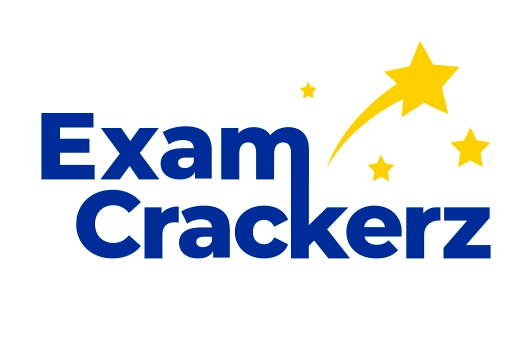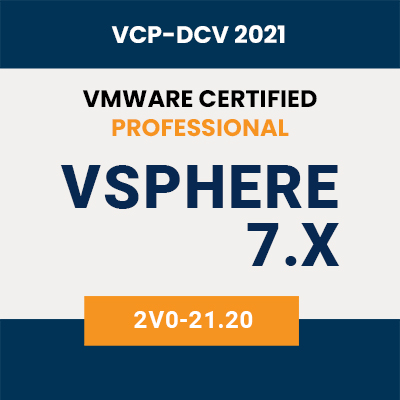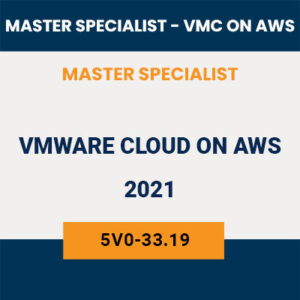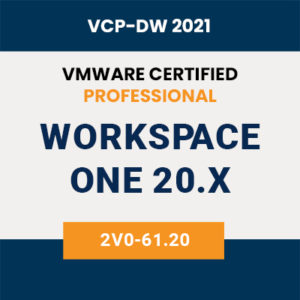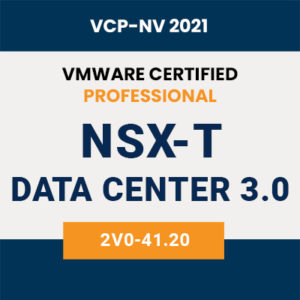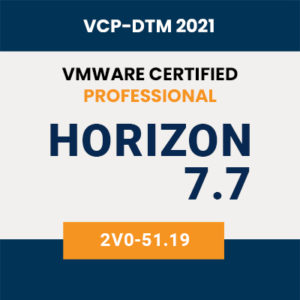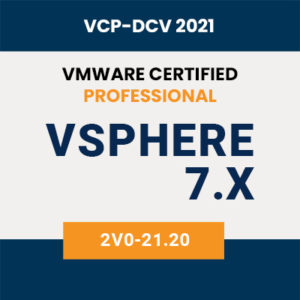Description
Exam Details
The Professional VMware vSphere 7.x Exam (2V0-21.20), which leads to the VMware Certified Professional – Data Center Virtualization 2020 certification is a 70-item exam with a passing score of 300 using a scaled method. Candidates are given an exam time of 130 minutes, which includes adequate time to complete the exam for non-native English speakers.
Exam Delivery
This is a proctored exam delivered through Pearson VUE. For more information, visit the Pearson VUE website.
Certification Information
For details and a complete list of requirements and recommendations for attainment, please reference the VMware Education Services – Certification website.
Minimally Qualified Candidate
A minimally qualified candidate (MQC) has 6-12 months hands-on experience implementing, managing, and troubleshooting a vSphere 7
infrastructure. They are typically administrators, capable of performing deployment and administration of a virtual infrastructure using vSphere. The candidate also has a working knowledge of storage, networking, hardware, security, business continuity, and disaster recovery
concepts.
Exam Sections
VMware exam blueprint sections are now standardized to the seven sections below, some of which may NOT be included in the final exam blueprint depending on the exam objectives.
Section 1 – Architecture and Technologies
Section 2 – Products and Solutions
Section 3 – Planning and Designing
Section 4 – Installing, Configuring, and Setup
Section 5 – Performance-tuning, Optimization, and Upgrades
Section 6 – Troubleshooting and Repairing
Section 7 – Administrative and Operational Tasks
If a section does not have testable objectives in this version of the exam, it will be noted below, accordingly. The objective numbering maybe referenced in your score report at the end of your testing event for further preparation should a retake of the exam be necessary.
Sections Included in this Exam
Section 1 –Architectures and Technologies
Objective 1.1 – Identify the pre-requisites and components for a vSphere implementation
Objective 1.2 – Describe vCenter Server topology
Objective 1.3 – Identify and differentiate storage access protocols for vSphere (NFS, iSCSI, SAN, etc.)
1.3.1 – Describe storage datastore types for vSphere
1.3.2 – Explain the importance of advanced storage configuration (vSphere Storage APIs for Storage Awareness (VASA),
vSphere Storage APIs Array Integration (VAAI), etc.)
1.3.3 – Describe storage policies
1.3.4 – Describe basic storage concepts in K8s, vSAN, and vSphere Virtual Volumes (vVols)
Objective 1.4 – Differentiate between vSphere Network I/O Control (NIOC) and vSphere Storage I/O Control (SIOC)
Objective 1.5 – Describe instant clone architecture and use cases
Objective 1.6 – Describe ESXi cluster concepts
1.6.1 – Describe Distributed Resource Scheduler (DRS)
1.6.2 – Describe vSphere Enhanced vMotion Compatibility (EVC)
1.6.3 – Describe how Distributed Resource Scheduler (DRS) scores virtual machines
1.6.4 – Describe vSphere High Availability
1.6.5 – Describe datastore clusters
Objective 1.7 – Identify vSphere distributed switch and vSphere standard switch capabilities
1.7.1 – Describe VMkernel networking
1.7.2 – Manage networking on multiple hosts with vSphere distributed switch
1.7.3 – Describe networking policies
1.7.4 – Manage Network I/O Control (NIOC) on a vSphere distributed switch
Objective 1.8 – Describe vSphere Lifecycle Manager concepts (baselines, cluster images, etc.)
Objective 1.9 – Describe the basics of vSAN as primary storage
1.9.1 – Identify basic vSAN requirements(networking, disk count + type)
Objective 1.10 – Describe the vSphere Trust Authority architecture
Objective 1.11 – Explain Software Guard Extensions (SGX)
Section 2 – VMware Products and Solutions
Objective 2.1 – Describe the role of vSphere in the software-defined data center (SDDC)
Objective 2.2 – Identify use cases for vCloud Foundation
Objective 2.3 – Identify migration options
Objective 2.4 – Identify DR use cases
Objective 2.5 – Describe vSphere integration with VMware Skyline
Section 3 – Planning and Designing – There are no testable objectives for this section.
Section 4 – Installing, Configuring, and Setup
Objective 4.1 – Describe single sign-on (SSO) deployment topology
4.1.1 – Configure a single sign-on (SSO) domain
4.1.2 – Join an existing single sign-on (SSO) domain
Objective 4.2 – Configure VSS advanced virtual networking options
Objective 4.3 – Set up identity sources
4.3.1 – Configure Identity Federation
4.3.2 – Configure Lightweight Directory Access Protocol (LDAP) integration
4.3.3 – Configure Active Directory integration
Objective 4.4 – Deploy and configure vCenter Server Appliance
Objective 4.5 – Create and configure VMware High Availability and advanced options (Admission Control, Proactive High Availability,
etc.)
Objective 4.6 – Deploy and configure vCenter Server High Availability
Objective 4.7 – Set up the content library
Objective 4.8 – Configure vCenter Server file-based backup
Objective 4.9 – Analyze basic log output from vSphere products
Objective 4.10 – Configure vSphere Trust Authority
Objective 4.11 – Configure vSphere certificates
4.11.1 – Describe Enterprise PKIs role for SSL certificates
Objective 4.12 – Configure vSphere Lifecycle Manager/VMware Update Manager (VUM)
Objective 4.13 – Securely Boot ESXi hosts
Objective 4.14 – Configure different network stacks
Objective 4.15 – Configure Host Profiles
Objective 4.16 – Identify boot options
4.16.1 – Configure Quick Boot
Section 5 – Performance-tuning, Optimization, Upgrades
Objective 5.1 – Identify resource pools use cases
5.1.1 – Explain shares, limits, and reservations (resource management)
Objective 5.2 – Monitor resources of vCenter Server Appliance and vSphere environment
Objective 5.3 – Identify and use tools for performance monitoring
Objective 5.4 – Configure Network I/O Control (NIOC)
Objective 5.5 – Configure Storage I/O Control (SIOC)
Objective 5.6 – Explain the performance impact of maintaining virtual machine snapshots
Objective 5.7 – Plan for upgrading various vSphere components
Section 6 – Troubleshooting and Repairing – There are no testable objectives for this section.
Section 7 – Administrative and Operational Tasks
Objective 7.1 – Create and manage virtual machine snapshots
Objective 7.2 – Create virtual machines using different methods (Open Virtual Machine Format (OVF) templates, content library,
etc.)
Objective 7.3 – Manage virtual machines
Objective 7.4 – Manage storage (datastores, storage policies, etc.)
7.4.1 – Configure and modify datastores (expand/upgrade existing datastore, etc.)
7.4.2 – Create virtual machine storage policies
7.4.3 – Configure storage cluster options
Objective 7.5 – Create Distributed Resource Scheduler (DRS) affinity and anti-affinity rules for common use cases
Objective 7.6 – Configure and perform different types of migrations
Objective 7.7 – Configure role-based user management
Objective 7.8 – Configure and manage the options for securing a vSphere environment (certificates, virtual machine encryption,
virtual Trusted Platform Module, lock-down mode, virtualization-based security, etc.)
Objective 7.9 – Configure and manage host profiles
Objective 7.10 – Utilize baselines to perform updates and upgrades
Objective 7.11 – Utilize vSphere Lifecycle Manager
7.11.1 – Describe Firmware upgrades for ESXi
7.11.2 – Describe ESXi updates
7.11.3 – Describe component and driver updates for ESXi
7.11.4 – Describe hardware compatibility check
7.11.5 – Describe ESXi cluster image export functionality
Objective 7.12 – Configure alarms
